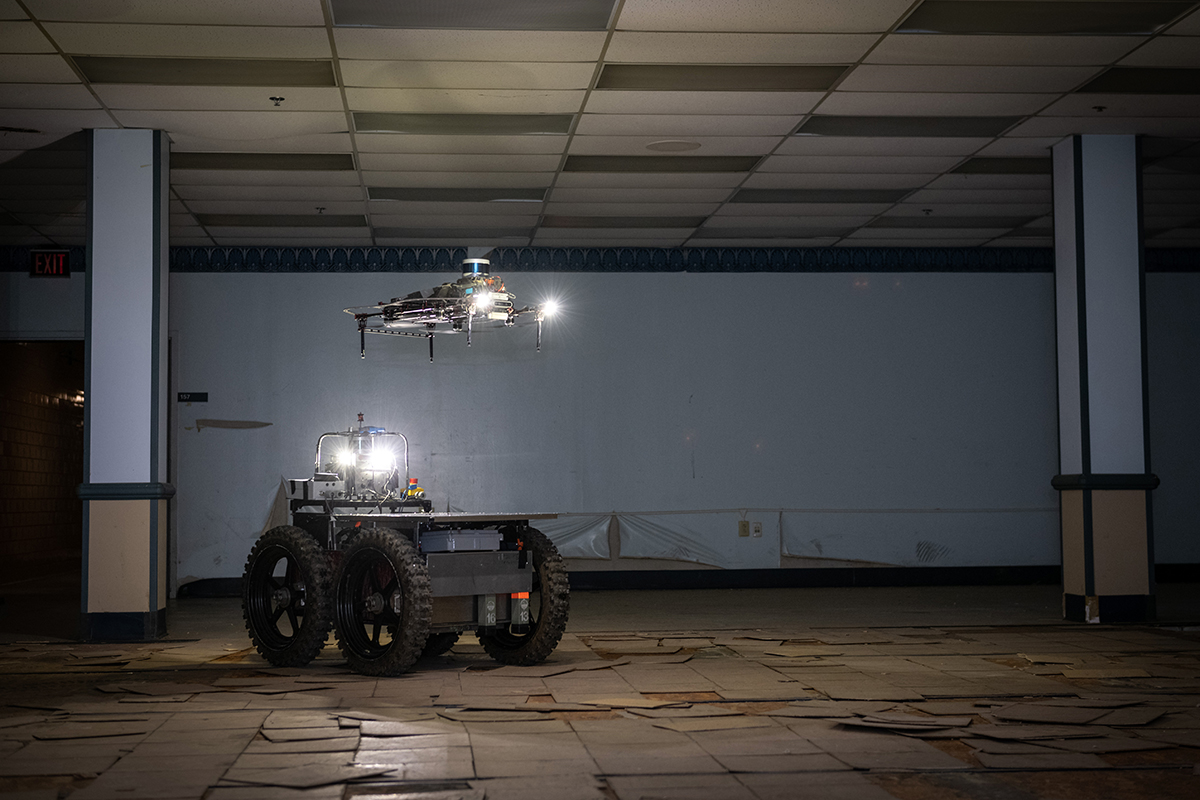Team Explorer Adds Capabilities for Latest DARPA Robotics Contest Robots Negotiate Stairs, Fly Through Narrow Doorways, Bounce Off Obstacles
Byron SpiceThursday, February 13, 2020Print this page.

Maneuvering wheeled robots up and down stairwells and flying drones slim enough to slip through narrow doorways and tough enough to survive collisions are among the new capabilities Team Explorer has added for the latest competition in the DARPA Subterranean Challenge.
Explorer, which includes researchers from Carnegie Mellon University and Oregon State University, is one of 11 teams that will send robots into the depths of an incomplete nuclear power plant in a search-and-rescue scenario. Teams have been told to be ready to search multiple levels and open spaces within the plant, looking for artifacts such as a simulated human survivor, a backpack, a cellphone, a vent and a mock gas leak.
The Urban Circuit is the second in a series of scored contests in the Defense Advanced Research Projects Agency's (DARPA) Subterranean Challenge, in which autonomous robots map underground environments and look for objects, much as a first responder might in an emergency. Teams are scored based on the number of artifacts that the robots accurately identify and map.
The Urban Circuit takes place Feb. 18–27 in Elma, Washington.
Explorer outscored the other competitors during the first contest, the Tunnel Circuit, this past August. But Matt Travers, who co-leads the team with Sebastian Scherer, said performance in coal mine tunnels doesn't necessarily predict success in the very different environment of a power plant.
"Searching across several levels and in a variety of spaces will require new equipment and even some new search tactics," he said. "In a tunnel, the artifacts are all fairly close to where our robots are driving anyway. In a plant, we're less constrained, so finding things may be more difficult."
Stairways are also a big challenge.
"Stairs are right at the upper limit of what's possible with a wheeled vehicle," said Travers, a systems scientist in CMU's Robotics Institute. Two of the team's wheeled robots each weigh close to 500 pounds, so getting them down a stairwell without flipping over is a feat. A third vehicle, weighing half as much but with the same power, has been added to the team's fleet because it can climb stairs.
But navigating stairs autonomously is not yet possible, said Steve Willits, the team's lead test engineer. The robots will be teleoperated on stairs because it is important to get and keep the robots properly aligned on the stairs.
In the previous contest, the robots had cameras that could transmit snapshots of artifacts to help the human operator, who was located on the surface, identify them. But teleoperation required that the team beef up the communications system to enable streaming video, Willits said. The streaming video also will provide a secondary means of verifying artifacts.
Changes also have been made to the team's drones.
"From the ground up, they've been designed to fly indoors," said Scherer, an associate research professor in the Robotics Institute. Each craft's four rotors, usually on the top corners of a drone, have been moved underneath and pushed closer together, so the drones are just 26 inches wide.
The drones also have been equipped with bumpers, anticipating that they will need to survive bumps and other collisions with walls, doorways, posts and equipment. Because they run out of power faster than ground vehicles, the drones will be carried on the backs of the wheeled robots until they need to be deployed.
Willits said the ground robots will make 360-degree turns before launching the drones, using their cameras to ensure that they're not near a pole or piece of equipment that a drone might strike when it becomes airborne.
In addition to Scherer and Travers, Geoff Hollinger, an associate professor of mechanical engineering at Oregon State, leads a team of researchers who specialize in coordinating multiple-robot teams. Explorer now has a fleet of seven robots, four or five of which will be deployed at any given time, said Chao Cao, a systems engineer in the CMU Robotics Institute who will be the team's lone operator during the competition.
Team Explorer is sponsored in the Urban Circuit by Microsoft, Honeywell, Epson, the Richard King Mellon Foundation and CNH Industrial.
Byron Spice | 412-268-9068 | bspice@cs.cmu.edu<br>Virginia Alvino Young | 412-268-8356 | vay@cmu.edu
